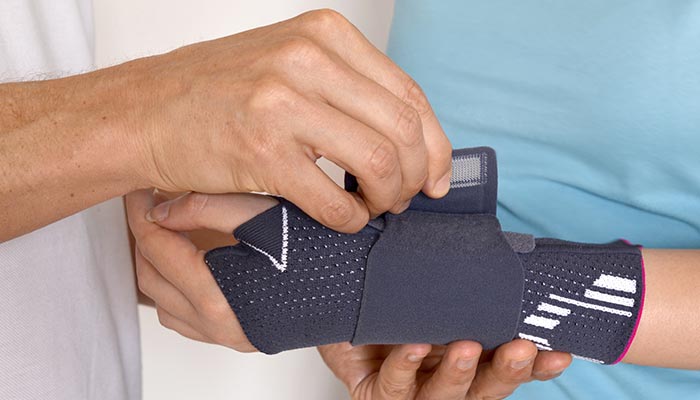Should You Use a Wrist Splint for Carpal Tunnel?
February 26th, 2020

Did you know that carpal tunnel syndrome affects 50 in every 1,000 people in the US? Meaning, 5% of the US population suffers from this painful condition!
What’s more, experts estimate that CTS represents 90% of all entrapment neuropathies. These disorders affect the peripheral nerves and usually cause pain and function loss.
If you think you have CTS, you should see a licensed therapist for a proper diagnosis. Otherwise, your symptoms will only worsen. Moreover, untreated carpal tunnel syndrome can cause nerve damage.
If you see a therapist early though, you may only have to wear a wrist splint for carpal tunnel. Wrist splints are some of the most common and non-invasive treatment options for CTS.
Ready to learn more about how these rehabilitative garments work? Then let’s dive right into it!
What Is Carpal Tunnel Syndrome?
The median nerve is one of the major nerves in the hand, running from the forearm all the way to the palm. This nerve is what allows you to feel through your fingers (except for the pinky). It’s also responsible for sending impulses, or nerve signals, to the muscle that goes to the thumb.
The carpal tunnel houses and protects the median nerve. We call it such because this part of the hand consists of a narrow (and firm) passageway for ligaments and bones.
Unfortunately, irritated and swollen tendons can make the carpal tunnel become even narrower. These inflammations can then compress or squeeze the median nerve. Carpal tunnel syndrome occurs due to this compression of the median nerve.
What Can Cause Inflammation That Results in CTS?
Carpal tunnel syndrome can result from inflammatory conditions like diabetes and rheumatoid arthritis. Repetitive strain injuries (RSIs), which affect 1.8 million US workers each year, can also cause CTS. Direct wrist injuries can also cause inflammation and lead to this condition.
How Can a Wrist Splint for Carpal Tunnel Help?
Carpal tunnel splints are wrist splints that look like tip-less or fingerless gloves. Also called wrist braces, these hand garments straighten and stabilize the wrist. This then reduces the pressure that “squeezes” the median nerve.
Relieving the pressure on a pressed median nerve helps minimize the symptoms of CTS. The stabilizing effects of a CTS splint also help “limit” wrist movements that can make the pain worse.
Why Use CTS Splints?
A carpal tunnel wrist brace or splint is most effective for minor to moderate cases. This is why it’s important to get an early diagnosis and prompt treatment for your condition. Leaving your CTS untreated can cause permanent damage to your median nerve.
If this happens, you may already need surgery to release the pressure on the nerve. Carpal tunnel surgery is effective in the long run, but pain following surgery is common. In fact, a study found that more than half of the surgery patients had pain even after three months.
Carpal tunnel release procedures have also shown to increase work disability and absences. In comparison, non-surgery patients had no absences that lasted for more than 2 weeks.
Wrist splints, on the other hand, doesn’t involve any kind of surgical procedure. Because it’s non-invasive, you don’t have to worry about adverse side effects. Many people can even wear them on the job!
Do You Always Have to Wear a Splint?
Most people wear a carpal tunnel wrist splint while they sleep. One reason is that sleeping and sleep positions raise one’s tendency to bend the wrists. This can then place more pressure on the already-squeezed median nerve.
If your CTS symptoms are worse in the morning or after waking up, wear a splint at night. This way, you can keep your wrist from bending, which can then help reduce pain, numbness, and tingling. Splinting at night has also shown to relieve CTS symptoms better than not using any treatment at all.
If you do a lot of repetitive activities, consider wearing custom wrist splints. This is because repetitive actions, such as typing or using a mouse, can trigger CTS flare-ups. In fact, any activity that involves moving the wrist over and over can make your symptoms worse.
Where Can You Get Wrist Splints?
Some types of wrist splints don’t need a prescription, so you’ll find these in local drugstores. These are the pre-fabricated or OTC splints. Since these are mass-produced, they’re your least expensive option.
A common issue with OTC splints is that they can either be too loose or too tight. Unfortunately, this defeats a splint’s purpose, which is to straighten the wrist. A too loose splint can also fail to provide enough support and stabilization to the wrist.
You can avoid these pitfalls by choosing to get custom wrist splints or braces instead. As the term suggests, these garments are specifically tailored to each patient. In fact, the first step to making these devices is to take a measurement of the patient’s affected hand.
As a result, custom splints have a near-perfect fit. Moreover, they’re adjustable, so you can loosen or tighten them anytime. Plus, quality splints and braces use lightweight materials that may feel more comfortable.
Reduce Your CTS Symptoms With a Quality Wrist Splint
There you have it, your ultimate guide on why you should wear a wrist splint for carpal tunnel syndrome. Used correctly, a CTS splint can help ease minor to moderate symptoms. Best of all, early treatment with a splint can help reduce your risks of having to undergo nerve surgery!
Just make sure that you gently exercise your wrist during and after you use a splint. This will help keep your wrist muscles from becoming weak. These soft movements can also help your wrist recover faster.
If you’re suffering from symptoms of carpal tunnel syndrome, know that we can help. Get in touch with us now so we can help you explore your treatment options!





